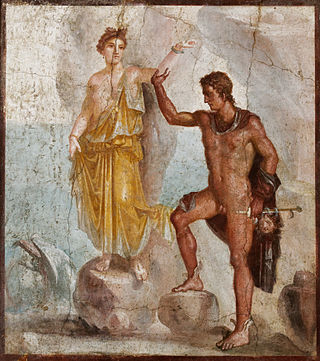
In Greek mythology, Andromeda is the daughter of Cepheus, the king of Aethiopia, and his wife, Cassiopeia. When Cassiopeia boasts that she is more beautiful than the Nereids, Poseidon sends the sea monster Cetus to ravage the coast of Aethiopia as divine punishment. Queen Cassiopeia understands that chaining Andromeda to a rock as a human sacrifice is what will appease Poseidon. Perseus finds her as he is coming back from his quest to decapitate Medusa, and brings her back to Greece to marry her and let her reign as his queen. With the head of Medusa, Perseus petrifies Cetus to stop it from terrorizing the coast any longer.

Minerva is the Roman goddess of wisdom, justice, law, victory, and the sponsor of arts, trade, and strategy. She is also a goddess of warfare, though with a focus on strategic warfare, rather than the violence of gods such as Mars. Beginning in the second century BC, the Romans equated her with the Greek goddess Athena. Minerva is one of the three Roman deities in the Capitoline Triad, along with Jupiter and Juno.

Pegasus is a winged horse in Greek mythology, usually depicted as a white stallion. He was sired by Poseidon, in his role as horse-god, and foaled by the Gorgon Medusa. Pegasus was the brother of Chrysaor, both born from Medusa's blood when their mother was decapitated by Perseus. Greco-Roman poets wrote about his ascent to heaven after his birth and his obeisance to Zeus, who instructed him to bring lightning and thunder from Olympus.
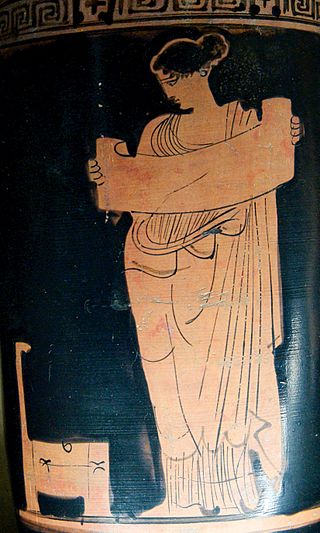
In ancient Greek religion and mythology, the Muses are the inspirational goddesses of literature, science, and the arts. They were considered the source of the knowledge embodied in the poetry, lyric songs, and myths that were related orally for centuries in ancient Greek culture.

In Greek mythology, Hippocrene is a spring on Mount Helicon. It was sacred to the Muses and was said to have formed when the winged horse Pegasus struck his hoof into the ground, whence its name which literally translates as "Steed/Horse's Fountain". The water was supposed to bring forth poetic inspiration when imbibed.

In Greek mythology, Perseus is the legendary founder of the Perseid dynasty. He was, alongside Cadmus and Bellerophon, the greatest Greek hero and slayer of monsters before the days of Heracles. He beheaded the Gorgon Medusa for Polydectes and saved Andromeda from the sea monster Cetus. He was the son of Zeus and the mortal Danaë, as well as the half-brother and great-grandfather of Heracles.
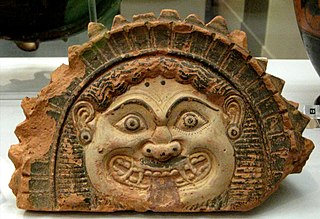
In Greek mythology, Medusa, also called Gorgo or the Gorgon, was one of the three Gorgons. Medusa is generally described as a woman with living snakes in place of hair; her appearance was so hideous that anyone who looked upon her was turned to stone. Medusa and her Gorgon sisters Euryale and Stheno were usually described as daughters of Phorcys and Ceto; of the three, only Medusa was mortal.

Mount Helicon is a mountain in the region of Thespiai in Boeotia, Greece, celebrated in Greek mythology. With an altitude of 1,749 metres (5,738 ft), it is located approximately 10 kilometres (6 mi) from the north coast of the Gulf of Corinth. Some researchers maintain that Helicon was also the Greek name of mount Rocca Salvatesta in Sicily as a river started from it was called also Helikon.
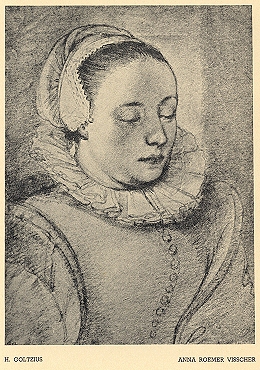
Anna Roemers Visscher was a Dutch artist, poet, and translator.

Joos de Momper the Younger or Joost de Momper the Younger was a Flemish landscape painter active in Antwerp between the late 16th century and the early 17th century. Brueghel's influence is clearly evident in many of de Momper's paintings. His work is situated at the transition from late 16th-century Mannerism to the greater realism in landscape painting that developed in the early 17th century. He achieved considerable success during his lifetime.

Pegasus Plaza is a public park located in downtown Dallas, Texas. Located at the corner of Akard and Main Street in the Main Street District, the plaza takes its name from Pegasus, the iconic sign atop the adjacent Magnolia Hotel and the mythical flying horse. The shaded plaza includes several fountains and is used for concerts, festivals and Christmas celebrations.
Pegasides were nymphs of Greek mythology connected with wells and springs, specifically those that the mythical horse Pegasus created by striking the ground with his hooves.

The Madonna at the Fountain is a 1439 oil on panel painting by the early Netherlandish artist Jan van Eyck. It belongs to van Eyck's late work, and is his last signed and dated painting. It retains its original frame, which bears the inscription; "ALS IXH CAN", "JOHES DE EYCK ME FECIT + [COM]PLEVIT ANNO 1439
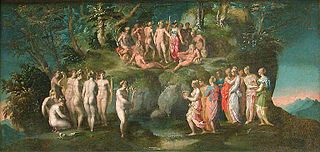
In Greek mythology, the Pierides or Emathides (Ἠμαθίδες) were the nine sisters who defied the Muses in a contest of song and, having been defeated, were turned into birds. The Muses themselves are sometimes called by this name.

In Greek mythology, Aganippe was the name of both a spring and the Naiad associated with it. The spring is in Boeotia, near Thespiae, at the base of Mount Helicon, and was associated with the Muses who were sometimes called Aganippides. Drinking from her well, it was considered to be a source of poetic inspiration. The nymph is called a daughter of the river-god Permessus. Ovid associates Aganippe with Hippocrene.

The Old Folks Sing, the Young Folks Chirp is a 1638–1640 oil-on-canvas painting by the Flemish artist Jacob Jordaens, now in the Royal Museum of Fine Arts Antwerp. He painted several works with this title, a Dutch proverb – this is the earliest of them, whilst another is now in Valenciennes.

Adrienne is a 1919 painting by the Flemish artist Gustave Van de Woestyne, now in the Royal Museum of Fine Arts, Antwerp. Its subjects are Adrienne de Zutter and her dog. It shows the influence of the English landscape artist William Turner, whose work de Woestyne had probably seen during the war.

Gaston and His Sister is a 1923 Expressionist oil on canvas painting by the Flemish artist Gustave Van de Woestijne, now in the Royal Museum of Fine Arts, Antwerp.

The Parisian Sphinx is an oil-on-canvas painting by Belgian painter Alfred Stevens. Painted between 1875 and 1877, it depicts a dreamy young woman gently supporting her head with her hand. The painting is part of the permanent collection of the Royal Museum of Fine Arts in Antwerp. The Parisian Sphinx shows the influence of Vermeer and the other Netherlandish old masters on Stevens, and testifies to the Symbolist influence in the latter's day. It incorporates a harmonious juxtaposition of superficial Dutch realism with the spreading Symbolist manner, as opposed to the bottom-up, pluralistic symbolism of the declining Romanticism.
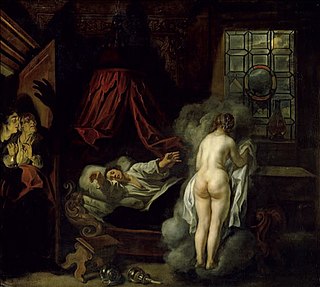
Nocturnal appearance or Night vision is a painting made by Jacob Jordaens around 1650. It is in the collection of the Staatliches Museum Schwerin. The title of the painting is also given as A dream. The meaning and subject of the painting depicting a nude woman seen from the back in a dark bedroom with a man asleep on a bed and two onlookers behind a half open door are still a matter of contention among art historians. A second version of the painting was at the Thore (Burger) sale in Paris on 1892, then in the van Hall sale in Antwerp in 1836 and finally in 1905 it was in Paris with art dealer Franz Kleinberger who exhibited it in Antwerp.






















